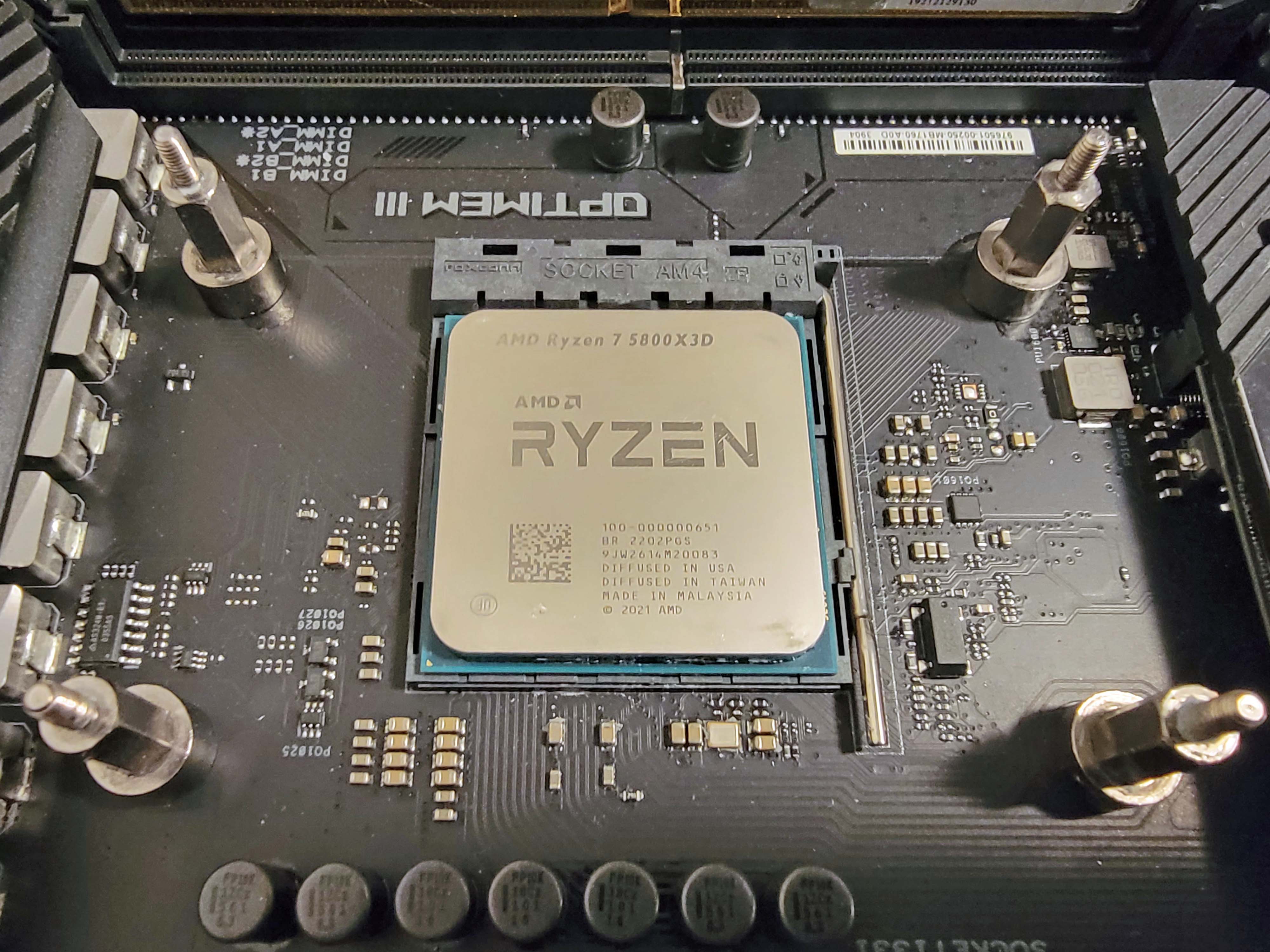Why you can trust Tom's Hardware
AMD Ryzen 7 5800X3D Boost Frequencies, Thermal Throttling Tests
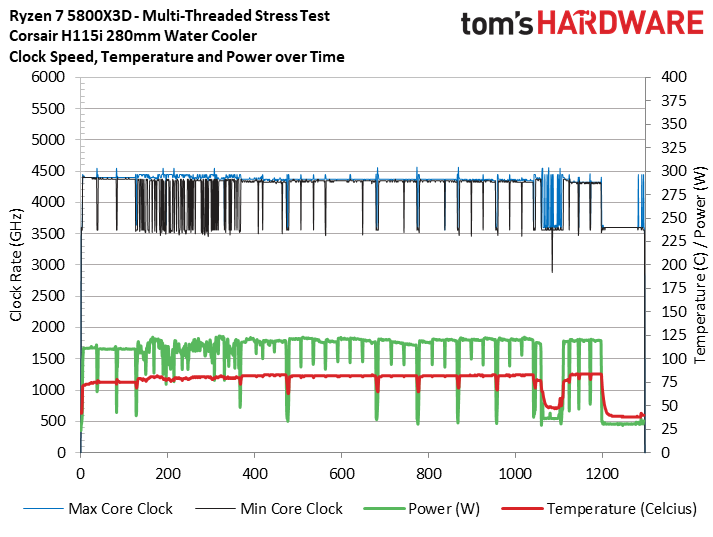
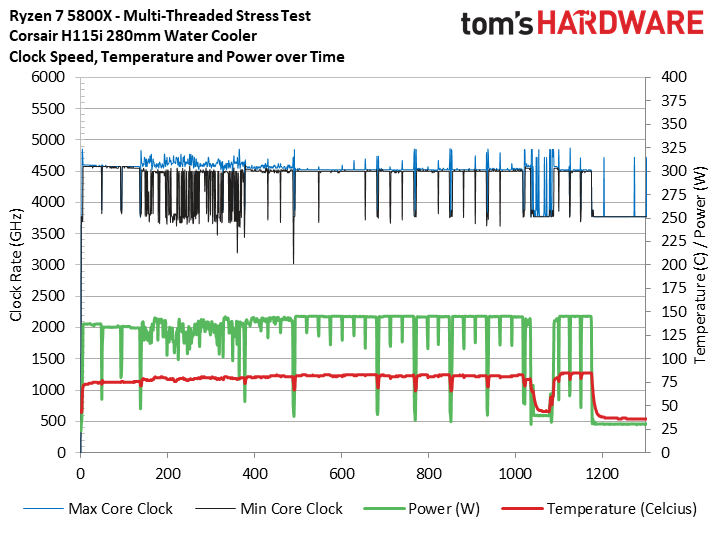
Thermal dissipation can limit a chip's peak performance, particularly as process nodes become denser. Adding in the complexity of a 3D-stacked design adds thermal challenges, in this case, exacerbated by the silicon shim stacked atop the CPU cores — this shim transfers heat from the cores to the integrated heat spreader (IHS), but could inevitably reduce the efficiency of the heat transfer from the cores. In effect, it could trap a small amount of heat. Signs of those challenges cropped up in our thermal and boost testing, leading us to conduct more in-depth testing to back up our findings.
The slides above show the Ryzen 7 5800X3D and its nearly-similar counterpart, the Ryzen 7 5800X, which doesn't have a 3D V-Cache design, running through a spate of standard heavily threaded applications (Cinebench, HandBrake, AVX-heavy y-cruncher) to measure power and thermals. We used a Corsair H115i 280mm AIO with the fans cranked to 100% to keep the chips as cool as possible during this test run.
The 5800X3D has a 400 MHz lower base and 200 MHz lower boost clock than the Ryzen 7 5800X, and we can see that the 5800X3D runs at 4.35 GHz during the heaviest multi-core workloads while the 5800X runs at 4.5 GHz. This is expected given the specifications, but we also noticed that the 5800X draws up to 145W while reaching those higher clock speeds, while the 5800X3D only peaks around 120W. This despite both chips having the same 105W TDP and 142W PPT.
Both chips reach the same peak around 80C during the heavy parts of the test, showing that the 5800X3D runs at the same temperature even though the 5800X is consuming 25W more power and running at higher clocks. AMD tells us that thermals aren't the limiting factor that prevents higher clock speeds or the allowance of higher voltages (and thus more heat) for overclocking, but these results certainly imply that the 3D-stacked design doesn't dissipate heat as well as the standard design. To investigate further, we ran a more intense test below.
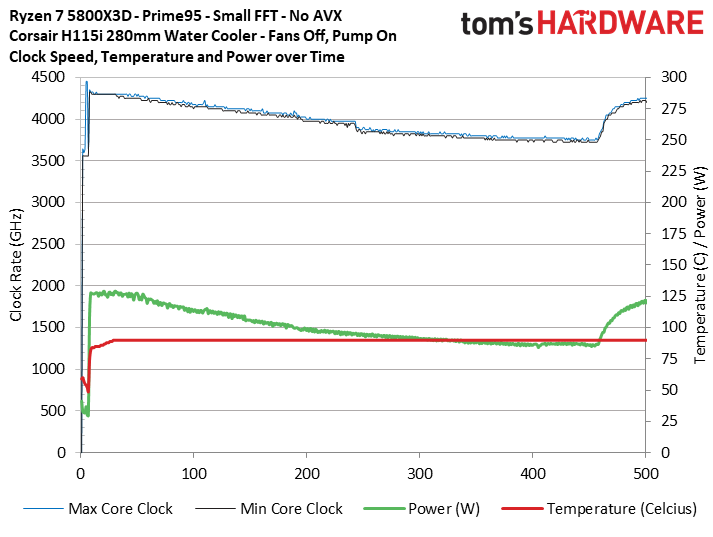

We turned to a Prime95 test under rigorous conditions to take a closer look at thermal dissipation. We often don't include Prime95 power measurements in our standard CPU reviews, largely because there is a massive disconnect between this extremely rigorous stress test and the power consumption and thermal load generated by most real-world applications. Still, we're specifically looking to push the chips to their throttle point for this test.
To push the processor's limits even harder, we unplugged the fans on the Corsair H115i cooler but left the pump running (unplugging the pump caused clocks to drop too rapidly for our logging to provide any granularity). We then kicked off a Prime95 run with small FFTs, but with AVX instructions disabled. This type of Prime 95 stress test is brutal, and you won't see this type of stress during even the heaviest normal use. As such, remember that we're doing this for science, and not as an indicator of how these chips would function in your PC.
The results clearly show that the 5800X3D peaks at 130W while the 5800X peaks at 145W. Then both chips reach a steady-state temperature of 90C before they begin aggressively throttling power, and thus clock speeds, to remain at this temperature threshold. You'll notice that the 5800X3D encounters this high temperature sooner than the 5800X, and it drops to lower clocks than the 5800X before the end of the test.
Additionally, the 5800X3D remains at 90C while drawing 86W at its lowest point, but the 5800X drew 110W at its lowest point at the same 90C. This shows that the 5800X3D doesn't dissipate as much thermal load as the 5800X within the same temperature threshold. In other words, if all else were equal, the 5800X3D would run hotter than the 5800X under identical conditions. In fact, even when consuming less power, the 5800X3D is undoubtedly hotter than the 5800X.
But to be clear: You would never encounter these conditions during normal use, and the Ryzen 7 5800X3D runs perfectly fine within its specifications. In fact, the 5800X3D is much cooler than the competing Core i9 processors.
Thermal dissipation has been one of the major sticking points that have prevented high-performance 3D chips from going mainstream, but AMD has done an amazing engineering job in bringing thermals under control enough to deliver a chip that provides excellent performance within an acceptable TDP threshold.
Our results certainly heavily imply that thermal dissipation will remain a serious challenge at higher power thresholds, and while AMD contends that voltage is the limiting factor that reigns in the 5800X3D's clock speeds and prohibits overclocking, there could be some room for interpretation of that statement. Most have taken AMD's statement to mean that heat isn't an issue, even though the company has also cited heat as a factor with 3D V-Cache at other times.
As a reminder, voltage, frequency, and thermals are all interrelated. Higher clock frequencies require more voltage, but more voltage results in more heat. A higher voltage may simply push the chip outside its comfortable thermal envelope. As such, 3D V-Cache's 1.35V limit may simply be a product definition designed to keep thermals in check given the chip's thermal design, and not be an actual physical limitation of the technology itself.
Get Tom's Hardware's best news and in-depth reviews, straight to your inbox.
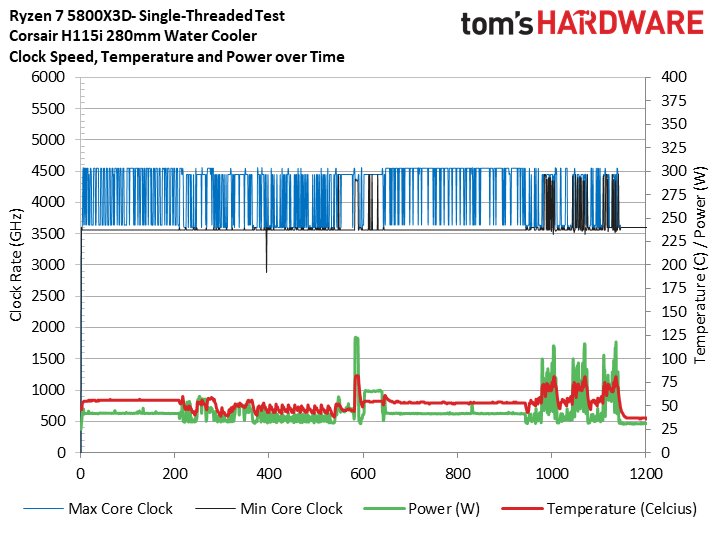
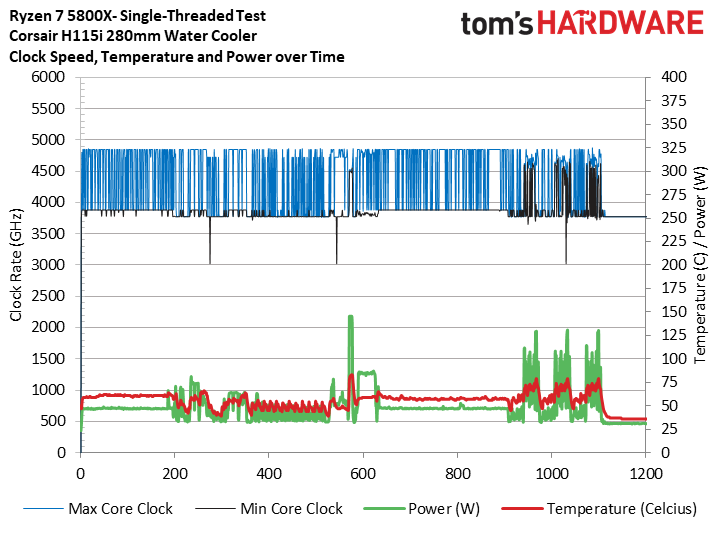
As part of our normal test regimen, we tested performance in lightly-threaded work with the H115i cooler. To assess peak boost speeds, we ran through our standard series of lightly-threaded tests (LAME, PCMark10, Geekbench, VRMark, and single-threaded Cinebench).
The 5800X3D reached its peak 4.5 GHz frequency frequently, while the 5800X actually exceeded its 4.7 GHz spec and regularly hit 4.8 GHz. Temperatures and power draw aren't a major concern through most of this test, but there are a series of multi-threaded Geekbench workloads near the 1000-second mark. Again, the 5800X draws more power and runs at higher clocks than the 5800X3D during these periods of heavy load, but it has nearly identical temperatures.
- MORE: Best CPUs for Gaming
- MORE: CPU Benchmark Hierarchy
- MORE: AMD vs Intel
- MORE: All CPUs Content
Current page: AMD Ryzen 7 5800X3D Boost Frequencies and Thermal Throttling Tests
Prev Page Ryzen 7 5800X3D: 3D V-Cache Tech, Design and Latency Testing Next Page AMD Ryzen 7 5800X3D Power Consumption, Efficiency, Thermals, Test Setup
Paul Alcorn is the Editor-in-Chief for Tom's Hardware US. He also writes news and reviews on CPUs, storage, and enterprise hardware.
